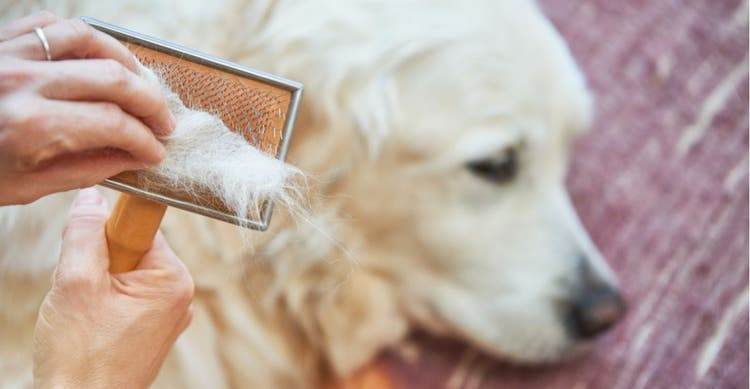
Why Is My Dog Shedding So Much?
The Basics of Shedding
The hair coat plays a variety of roles in an animal’s overall health including: thermal insulation, sensory function, sexual and social communication, and protective function for the skin. The hair cycle is made up of a growing phase (anagen), resting phase (telogen), and shedding phase (exogen). Shedding is a normal and natural part of the hair cycle.
Shedding is influenced by many factors, including amount of daylight (photoperiod), ambient temperature, nutrition, hormones, overall health, coat type, and numerous other intrinsic factors. With normal variations in the amount of shedding seen, it can be a challenge to know if your pet’s hair loss is a normal fluctuation or sign of a more serious problem.
The hair cycle in dogs occurs in a mosaic pattern, meaning that hair follicles next to each other are never in the same phase of the hair cycle at the same time. One of the main changes to watch for would be a noticeable thinning of the hair coat, breaking of the hairs, alopecic patches (bald spots), and/or other skin changes associated with the hair loss.
Causes of Hair Loss in Dogs
Here are common conditions that lead to canine hair loss:
Allergic Disease
Allergies, whether they are food or environmental, cause inflammation of the skin and hair follicles, which will increase shedding. Usually, secondary bacterial infection of the follicles (folliculitis) occurs and increases hair loss. Hair loss seen with bacterial folliculitis is often presented in circular patches. Additionally, you may notice shorter or broken hairs in areas where your pet licks, chews, or scratches. The skin associated with hair loss in allergic pets may be red or crusted.
Immune-Mediated Hair Loss
Sebaceous adenitis is the most common immune- mediated disease that affects the hair coat. This disease results in destruction of the oil glands (aka sebaceous glands), which leads to marked scaling, breakage of hair, and, ultimately, bald spots. Before hair loss or scale is noted, you may see coat changes, like darkening of hair or variation in texture. With this disease, hair may fall out easily or you may notice large amounts of hair around the house. Although any breed can develop sebaceous adenitis, standard poodles and Akitas are the most commonly affected. Biopsies are often required for diagnosis of immune-mediated causes of hair loss.
Hormonal Changes
The hair cycle is very sensitive to changes in circulating hormone levels. Full blood work may be requested for aging dogs with hair loss to look for a low thyroid (hypothyroidism) or increased cortisol (Cushing’s disease). Hormonal hair loss typically affects the trunk of the body and spares the head and limbs. Areas of friction like collar lines, tails, and thighs are often prone to hair loss with hormonal changes. In fluffy or plush-coated breeds, a sex hormone imbalance called Alopecia X can also result in hair less. These dogs are generally not itchy and do not have the inflamed skin associated with the hair loss. Occasionally, additional systemic signs, such as change in energy level, weight gain, or appetite, may be seen with hormonal changes.
Breed or Coat Color-Specific Hair Loss
Certain breeds have congenital malformation of the hair follicles (follicular dysplasia), which causes hair loss as dogs age. Blue or fawn color coats can be prone to a type of hair loss known as color dilution alopecia. Many short-coated dogs, like Dachshunds and Chihuahuas, can develop pattern baldness which causes hair loss on the head, ears, chest, and thighs.
In most cases, shedding is very normal for dogs. However, if you are concerned that your dog is excessively shedding, consulting with a veterinarian can help determine if there is an underlying, contributing health issue. Once they get the “all clear” health wise, if you still want to reduce the amount of hair that is shed into the environment, routine grooming with bathing and brushing (for normal and long coat dogs) can be helpful. Otherwise, frequent vacuuming and lint rolling are just part of having a furry friend around the house!